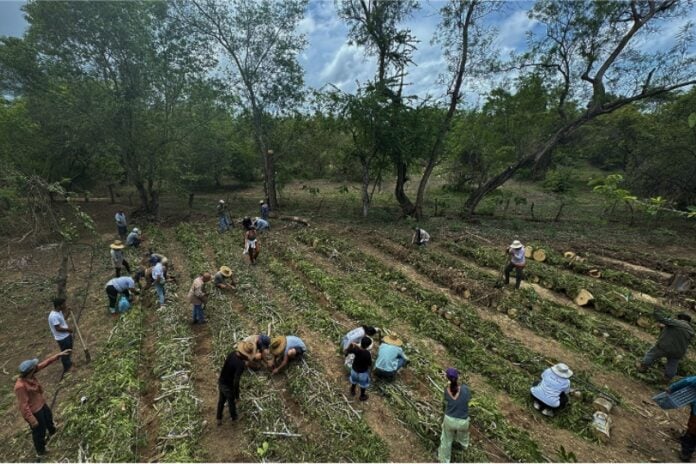At dawn in Juluchuca, on Mexico’s Costa Grande, a chorus of herons rises from mangroves that only a generation ago withered and choked under cattle and coconut monocultures. Today, brackish water snakes through the estuary, shrimp flick in the shallows, and kids test the clarity with homemade kits. What began at Playa Viva, an off-grid eco-resort 35 kilometers south of Ixtapa-Zihuatanejo, as a small experiment in healing land has now become a seed for ReSiMar — a model for restoring watersheds and rebuilding communities “from ridge to reef” all along Mexico’s Pacific Coast.
The roots of regeneration
Two decades ago, long before ReSiMar had a name, master permaculture designer Odin Ruz arrived to survey a scarred landscape. Coconut-palm monocultures had drained the wetlands and killed the lagoons. A few early planning sessions by the Regenesis Group had helped outline the project’s broad vision, but it was Ruz who translated that vision into practice.
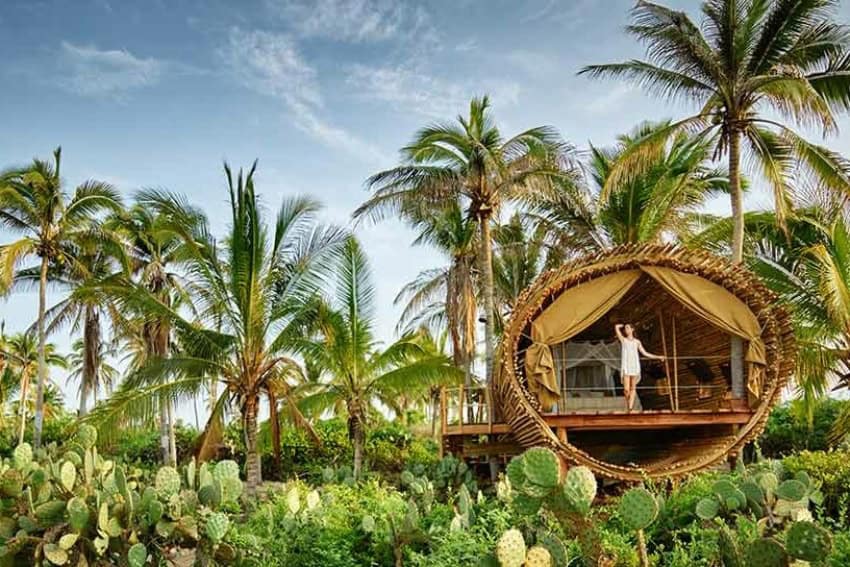
“Before we started building, the most important thing was to observe,” Ruz said. “We waited two years for the permits, so I used that time to study how the water moved, how the mangrove breathed through the different seasons.”
Ruz’s team reopened blocked estuary channels, planted red, white, and black mangroves, and mapped the entire property according to natural water flow. “The first design you make on a piece of land establishes how everything will be developed from there,” he said. “It was about sowing in the permaculture.”
One of the biggest obstacles was the skepticism from nearby fishermen who had long cut mangroves to clear their nets and “clean up” the landscape.
“We had to talk to the fishermen,” he recalled, who had seen their shrimp catches decline precipitously.
Restoring confidence
“You have to restore the mind of the people before you can restore the ecosystem,” Ruz said. By linking shrimp abundance to mangrove health, he slowly turned adversaries into allies.
Behind the venture stood hotel founders David Leventhal and Sandra Kahn. Their modest idea — to build a small lodge that lived lightly on the land — set the tone for what Leventhal later called “luxury in nature.”
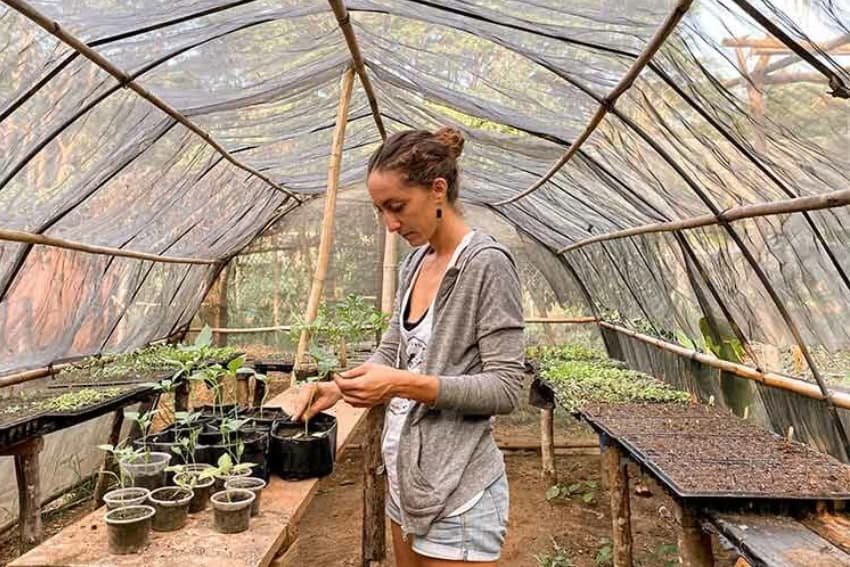
Ruz led the permaculture project for around a decade before leaving in about 2016. He stays in touch with the owners and still visits occasionally. He describes how the transformation can be felt as you enter the land, noting that the contrast from the degraded surroundings to the regenerated core of Playa Viva is immediate.
Walking through Playa Viva’s gate, visitors leave behind dust and dryness for an immersive, living oasis. It’s like going from a black and white movie to one in color. After cresting a dune, you see beautiful constructions hiding among the trees and flowers, linked by these little trails from one cabin to another.
From eco-resort to ReSiMar
Over the nearly two decades since Leventhal and Kahn bought the land, the dusty pastures of Juluchuca gave way to a vibrant mangrove forest, lush gardens, a revived lagoon, and a growing trickle of guests drawn by the experiment. By 2018, that experiment had formalized into ReSiMar, a collaborative program linking Playa Viva with the nonprofit Legacy Regenerativa México, led by systems designer James Honey, Mexico Director for LegacyWorks Group.
The story of regeneration at Playa Viva is centuries deep. Long before building began, the team researched Playa Viva’s ancient use. The earliest known inhabitants of this region were the Cuicatecos, an Indigenous people whose culture was shaped by contact with powerful neighboring civilizations — first Teotihuacán, then the Toltecs. Archaeologists note that the Toltec and Teotihuacán influence reached deep into rural societies, bringing advanced technologies, social organization and art to the region.
“Before David and Sandra even put a shovel in the ground here, what they did was work with Bill Reed to create a history of place,” said Kerry Skinner, Playa Viva’s marketing and special projects manager. “We have information on the land here, dating back from the artifacts … showing that the community created agricultural terraces that we now use on our permaculture farm as swales to plant water. That history of place really dictates everything that we do.”
Perhaps not coincidentally, the Cuicatecos are noted by scholars for possessing a remarkable traditional ecological knowledge — managing biodiversity, regulating hunting and gathering, and maintaining sustainable relationships with their forests and animals. Their worldview equated the health of the land and animals with the well-being of the community, and communitarian rules for conservation remain vital to their culture today. The last speaker of the Cuitlatec (Cuicatlateco) language died in the 1960s, leaving no descendants.
A legacy of sustainability

This legacy of careful management — and the belief that land, water and community are inseparable — finds new life at Playa Viva. Honey described ReSiMar as “a living laboratory for watershed regeneration” organized around five nodes — water, permaculture and agroecology, education, terrestrial conservation and marine conservation — that are woven together by governance, storytelling and financial sustainability. “It’s about connecting communities from the mountains to the sea,” he said. “When people understand the whole system, they begin to act as one watershed.”
Skinner helps translate that science into everyday experience for guests and partners. “For Playa Viva, the aim is always to give guests a different kind of tourist experience,” she said. “You really can make a positive impact when you travel beyond just flying and flopping and having a nice time. Whether it’s releasing a baby turtle or sitting down with community leaders to hear about our restoration work.”
Measuring the change
Nearly 20 years after Ruz first redrew the hydrology map, the results are visible and, importantly, measurable. According to Honey, ReSiMar monitors biological and social indicators across the 30-square-kilometer watershed.
“One of the pieces I’m most excited about is our citizens’ water monitoring that’s taking place now,” said Honey. “We have a water coordinator. The citizens’ water monitoring is a way for students, parents, agriculturalists, ranchers and ejido members to go out, and via several natural indicators … they’re looking at what’s happening with their water.”
Citizens Water Monitoring is a program of Fondo para la Comunicación y Educación Ambiental (FCEA). The group’s staff are the innovators behind, among others, Mexico’s premier portal on water issues: Agua.org.mx. The system FCEA has developed, based on simple natural indicators like bugs in the water or plants on the banks, is being used by another major conservation organization, Fondo Mexicano para la Conservación de la Naturaleza. Over 30 watershed restoration efforts across Mexico are now monitored by citizens with this method.
Students are now at the forefront of environmental change in Juluchuca’s watershed, according to Honey, and they’ve earned the new title of eco-agentes. Over the coming year, youth and local residents will collect data and start asking what actions they want to take next.
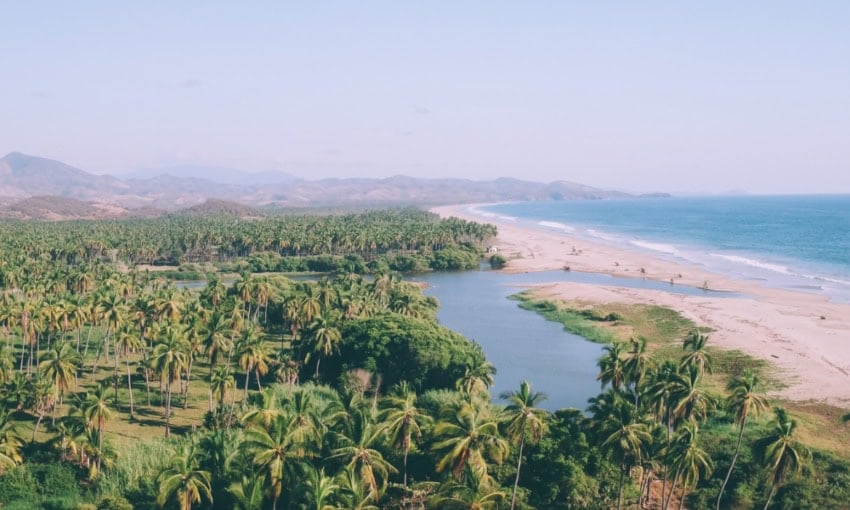
When children spark these challenging conversations, adults are more inclined to rethink longstanding community habits, such as livestock or chemical management, Honey points out.
“These are tough things. It’s how we’re managing our cattle, how much pesticide or herbicide we’re spraying on our mangoes,” he said. “This is really exciting, to think about youth asking those questions and leading the early action. We humans all tend to listen to our youth.”
A new curriculum
ReSiMar developed a formal year-long regenerative education curriculum in partnership with Enseña por México and Mexicanos Primeros — one designed to restore “sensitivity, observation and creativity in students.”
As Skinner explains, “That curriculum that was born here in this watershed is now like a formalized project proposal that could be rolled out in schools across the country. Enseña por México and Mexicanos Primeros both have collaborated on this project and formalized our regenerative education curriculum into a replicable guide. The aim is for it to be rolled out in schools across Mexico and beyond.”
Education advocates say the impact is already visible. Patricia Vazquez, CEO of Mexicanos Primero, notes: “Investing in education is investing in regeneration itself. Through our partnership with MIA, the Juluchuca summer learning camps showed that when children learn at their real level and reconnect with nature, their progress in reading, math and confidence grows in just weeks — proving that the future we want starts in the classroom.”
The quiet revolution: women at the center
The project’s most transformative design may be social: the expansion of leadership and agency to local women for the first time in the community’s history. The permaculture team’s founding of the Juluchuca Women’s Cooperative has meant much more than adding hands to the farm or introducing seasonal crops like turmeric and moringa. For many participants — some recent college graduates, some mothers — the cooperative is redefining possibility in a place where women’s public roles, farm management and ecological leadership were rare until now.
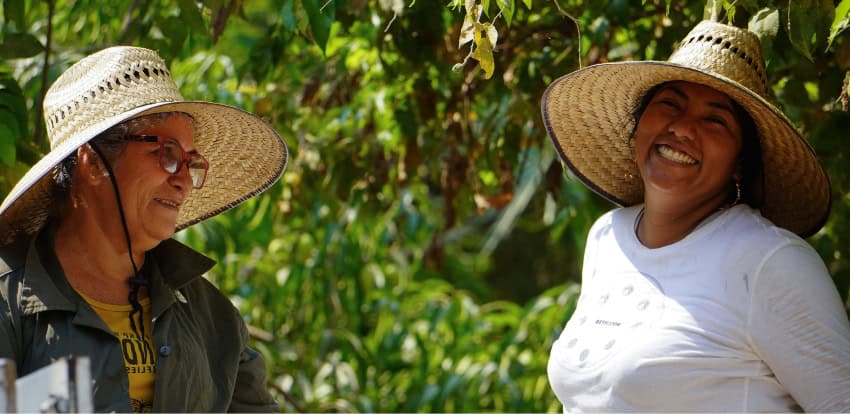
Beyond the Women’s Cooperative, four female Mexican node leaders are running ReSiMar on the ground: Ximena Rodríguez, Osmaira Hernández, Larissa Hernández and Viridiana Contreras.
“I can’t help but think that when the entirety of the operation is run by young women,” Honey reflects, “that that is not in every single moment changing our collective assumption about what is possible. And so that may be perhaps our biggest impact. It won’t be in the acres, and it won’t be in the curcuma, and it won’t be in the turtle yields. But it may very well be in what we will see one generation along the line because of who these women are and what they’re doing in that community.”
Nature-oriented design
Playa Viva is designed to blur the boundary between human dwelling and thriving ecosystem. The resort operates completely off-grid through solar arrays and battery storage, its water managed by systems that capture, filter and reuse greywater. Buildings are raised with bamboo, local woods and adobe, crafted to allow breezes and birdsong to pass through wide, open walls. From the moment visitors arrive, they move along winding trails under the forest canopy, passing native plantings that restore the old dune and estuary corridors. Every structure sits lightly on the land, clustered carefully to maximize shade, breezes and vistas, while leaving wildlife corridors intact.
The communal heart is the dining area, intentionally designed for meeting others. “The communal area — even the dining room is one big piece,” explained Ruz. “You sit down, and somebody’s on your side, and you start talking. It’s what’s called social architecture —the space is meant to bring people together, not separate them. Here, you’re kind of obligated to interact by how it’s planned.”
Education as Regeneration
If women’s leadership is the most transformative aspect of ReSiMar’s design, education is its clearest metric for change. The project’s regenerative curriculum, created with Enseña Por México and Mexicanos Primero, now moves from pilot to practice in Juluchuca’s schools. It’s “a formalized project proposal that could be rolled out in schools across the country,” as the team describes, aiming to restore “sensitivity, observation and creativity in students.”
As ReSiMar’s educational model evolves, the results are already visible in the watershed schools. Patricia Vazquez, CEO of Mexicanos Primero, pointed out: “Investing in education is investing in regeneration itself. Through our partnership with MIA, the Juluchuca summer learning camps showed that when children learn at their real level and reconnect with nature, their progress in reading, math and confidence grows in just weeks — proving that the future we want starts in the classroom.”

The “Adopt a Student” program — funded by Playa Viva guests and other donors — keeps local kids in school by covering uniforms, materials and fees that otherwise force dropouts. Many of the first “adopted” students now mentor younger children and lead summer programs, creating a virtuous circle for the next generation. Meanwhile, the local women’s cooperative turns skills learned on the farm into small businesses, keeping income in the community and cementing regeneration as a family value.
“Regeneration begins in the collective mind,” Honey says of the strategy. “When people change how they see the land, policy and economy follow.”
Scaling the model
The ReSiMar team is now applying the Juluchuca template beyond Guerrero. LegacyWorks has helped convene regional alliances in Costalegre, Baja California Sur and Oaxaca, where communities and developers are experimenting with ridge-to-reef planning. Honey described a “spiral of impact” that starts small, deepens locally and then expands outward.
The Mexican Forestry Commission (CONAFOR), Mexicanos Primero, Enseña Por México and many other organizations have collaborated, while new tourism investors cite Playa Viva as proof that regeneration can be profitable. The approach, Honey notes, is about “creating common vision, space for everyone. And then the results give back far beyond what you gave. That’s fundamental. And we’ve known that for a long time.”
With reporting by Chris Havler-Barrett
Tracy L. Barnett is a freelance writer based in Guadalajara. She is the founder of The Esperanza Project, a bilingual magazine covering social change movements in the Americas.
